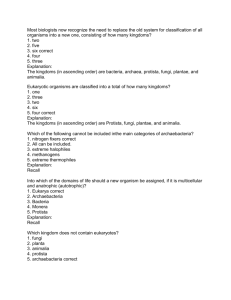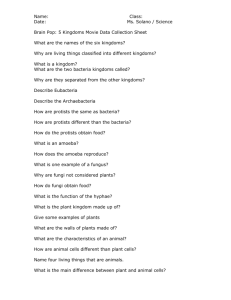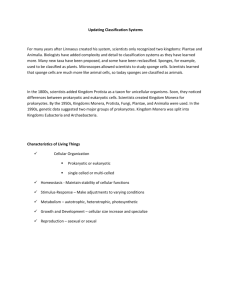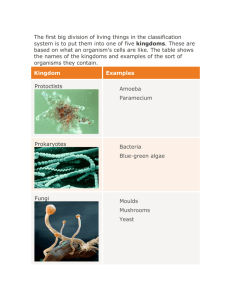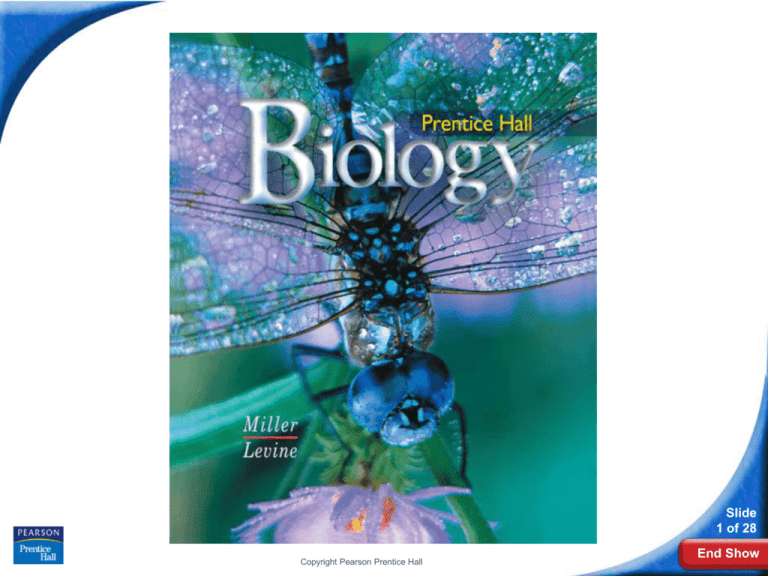
Biology
Slide
1 of 28
Copyright Pearson Prentice Hall
End Show
18-3 Kingdoms and Domains
Slide
2 of 28
Copyright Pearson Prentice Hall
End Show
18-3 Kingdoms and Domains
The Tree of Life Evolves
The Tree of Life Evolves
Systems of classification adapt to new
discoveries.
Linnaeus classified organisms into two kingdoms—
animals and plants.
Slide
3 of 28
Copyright Pearson Prentice Hall
End Show
18-3 Kingdoms and Domains
The Tree of Life Evolves
Five Kingdoms
Scientists realized there were enough differences
among organisms to make 5 kingdoms:
• Monera
• Protista
• Fungi
• Plantae
• Animalia
Slide
4 of 28
Copyright Pearson Prentice Hall
End Show
18-3 Kingdoms and Domains
The Tree of Life Evolves
Six Kingdoms
Recently, biologists recognized that Monera were
composed of two distinct groups: Eubacteria and
Archaebacteria.
Slide
5 of 28
Copyright Pearson Prentice Hall
End Show
18-3 Kingdoms and Domains
The Tree of Life Evolves
The six-kingdom system of classification
includes:
• Eubacteria
• Archaebacteria
• Protista
• Fungi
• Plantae
• Animalia
Slide
6 of 28
Copyright Pearson Prentice Hall
End Show
18-3 Kingdoms and Domains
The Tree of Life Evolves
Changing Number of Kingdoms
Names of Kingdoms
Introduced
1700’s
Late 1800’s
1950’s
1990’s
Plantae
Plantae
Protista
Monera
Eubacteria
Animalia
Archaebacteria
Animalia
Protista
Fungi
Plantae
Animalia
Protista
Fungi
Plantae
Animalia
Slide
7 of 28
Copyright Pearson Prentice Hall
End Show
18-3 Kingdoms and Domains
The Three-Domain System
The Three-Domain System
Molecular analyses have given rise to a new
taxonomic category that is now recognized by
many scientists.
The domain is a more inclusive category than any
other — larger than a kingdom.
Slide
8 of 28
Copyright Pearson Prentice Hall
End Show
18-3 Kingdoms and Domains
Slide
9 of 28
Copyright Pearson Prentice Hall
End Show
18-3 Kingdoms and Domains
The Three-Domain System
The three domains are:
• Eukarya, which is composed of protists,
fungi, plants, and animals.
• Bacteria, which corresponds to the kingdom
Eubacteria.
• Archaea, which corresponds to the kingdom
Archaebacteria.
Slide
10 of 28
Copyright Pearson Prentice Hall
End Show
18-3 Kingdoms and Domains
Slide
11 of 28
Copyright Pearson Prentice Hall
End Show
18-3 Kingdoms and Domains
Slide
12 of 28
Copyright Pearson Prentice Hall
End Show
18-3 Kingdoms and Domains
Domain Bacteria
Domain Bacteria
Members of the domain Bacteria are unicellular
prokaryotes.
Their cells have thick, rigid cell walls that surround
a cell membrane.
Their cell walls contain peptidoglycan.
Slide
13 of 28
Copyright Pearson Prentice Hall
End Show
18-3 Kingdoms and Domains
Domain Bacteria
The domain Bacteria
corresponds to the
kingdom
Eubacteria.
Slide
14 of 28
Copyright Pearson Prentice Hall
End Show
18-3 Kingdoms and Domains
Domain Archaea
Domain Archaea
Members of the domain Archaea are unicellular
prokaryotes.
Many live in extreme environments.
Their cell walls lack peptidoglycan, and their cell
membranes contain unusual lipids not found in any
other organism.
Slide
15 of 28
Copyright Pearson Prentice Hall
End Show
18-3 Kingdoms and Domains
Domain Archaea
The domain
Archaea
corresponds to
the kingdom
Archaebacteria.
Slide
16 of 28
Copyright Pearson Prentice Hall
End Show
18-3 Kingdoms and Domains
Domain Eukarya
Domain Eukarya
The domain Eukarya consists of organisms that
have a nucleus.
This domain is organized into four kingdoms:
• Protista
• Fungi
• Plantae
• Animalia
Slide
17 of 28
Copyright Pearson Prentice Hall
End Show
18-3 Kingdoms and Domains
Domain Eukarya
Protista
The kingdom Protista is composed of eukaryotic
organisms that cannot be classified as animals,
plants, or fungi.
Its members display the greatest variety.
They can be unicellular or multicellular;
photosynthetic or heterotrophic; and can share
characteristics with plants, fungi, or animals.
Slide
18 of 28
Copyright Pearson Prentice Hall
End Show
18-3 Kingdoms and Domains
Domain Eukarya
Fungi
Members of the kingdom Fungi are heterotrophs.
Most fungi feed on dead or decaying organic
matter by secreting digestive enzymes into it and
absorbing small food molecules into their bodies.
They can be either multicellular (mushrooms) or
unicellular (yeasts).
Slide
19 of 28
Copyright Pearson Prentice Hall
End Show
18-3 Kingdoms and Domains
Domain Eukarya
Plantae
Members of the kingdom Plantae are multicellular,
photosynthetic autotrophs.
Plants are nonmotile—they cannot move from
place to place.
Plants have cell walls that contain cellulose.
Slide
20 of 28
Copyright Pearson Prentice Hall
End Show
18-3 Kingdoms and Domains
Domain Eukarya
Animalia
Members of the kingdom Animalia are
multicellular and heterotrophic.
The cells of animals do not have cell walls.
There is great diversity within the animal kingdom,
and many species exist in nearly every part of the
planet.
Slide
21 of 28
Copyright Pearson Prentice Hall
End Show
18-3
Click to Launch:
Continue to:
- or -
Slide
22 of 28
End Show
Copyright Pearson Prentice Hall
18-3
Organisms whose cell walls contain
peptidoglycan belong in the kingdom
a. Fungi.
b. Eubacteria.
c. Plantae.
d. Archaebacteria.
Slide
23 of 28
End Show
Copyright Pearson Prentice Hall
18-3
Multicellular organisms with no cell walls or
chloroplasts are members of the kingdom
a. Animalia.
b. Protista.
c. Plantae.
d. Fungi.
Slide
24 of 28
End Show
Copyright Pearson Prentice Hall
18-3
Organisms that have cell walls containing
cellulose are found in
a. Eubacteria and Plantae.
b. Fungi and Plantae.
c. Plantae and Protista.
d. Plantae only.
Slide
25 of 28
End Show
Copyright Pearson Prentice Hall
18-3
Molecular analyses have given rise to a new
taxonomic classification that includes
a. three domains.
b. seven kingdoms.
c. two domains.
d. five kingdoms.
Slide
26 of 28
End Show
Copyright Pearson Prentice Hall
18-3
Which of the following contain more than one
kingdom?
a. only Archaea
b. only Bacteria
c. only Eukarya
d. both Eukarya and Archaea
Slide
27 of 28
End Show
Copyright Pearson Prentice Hall
END OF SECTION





